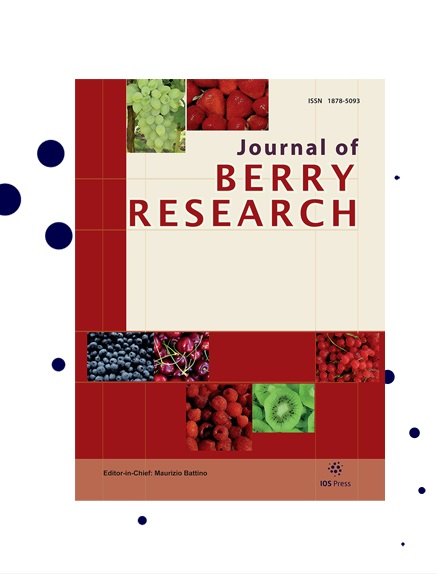Key genes for phenylpropanoid metabolite biosynthesis during half-highbush blueberry (Vaccinium angustifolium×Vaccinium corymbosum) fruit development
IF 1.4
4区 农林科学
Q3 PLANT SCIENCES
引用次数: 1
Abstract
BACKGROUND: Blueberry fruits contain large amounts of phenolic compounds derived from the phenylpropanoid pathway. Their biosynthesis is complex, involving many enzymes. OBJECTIVE: We sought to investigate the content of phenylpropanoid-derived compounds and identify key genes involved in the phenylpropanoid metabolite pathway during half-highbush blueberry fruit development. METHODS: Phenylpropanoid metabolite contents were determined by high-performance liquid chromatography (HPLC) and spectrophotometry. Gene expression was examined through reverse-transcription PCR. RESULTS: Phloretin, chlorogenic acid, total flavonol, quercetin, catechin, and proanthocyanidin contents were highest in small-sized green fruits; myricetin and epicatechin contents were highest in pink fruits; and lignin and anthocyanin were highest in blue fruits. Genes from the 4-coumarate CoA ligase (4CL) family regulate the biosynthesis of phenylpropanoid metabolites. Phenylalanine ammonia-lyase (PAL) and cinnamoyl-CoA reductase (CCR) are key genes in the lignin biosynthetic pathway. Flavonol synthase (FLS) is a key gene affecting total flavonols and the quercetin biosynthetic pathway. PAL and chalcone isomerase (CHI) are key genes in the epicatechin and anthocyanin biosynthetic pathways, respectively. CONCLUSION: Phenylpropanoid metabolites are regulated by multiple genes from the same or different families. Enzymes in different metabolic pathways compete for precursors to form a complex regulatory network for phenylalanine metabolism.半高丛蓝莓(Vaccinium angustifolium×Vaccinium corymbosum)果实发育过程中苯丙素代谢物生物合成的关键基因
背景:蓝莓果实含有大量来自苯丙素途径的酚类化合物。它们的生物合成是复杂的,涉及许多酶。目的:研究半高丛蓝莓果实发育过程中苯丙烷类化合物的含量,并确定苯丙烷类代谢途径的关键基因。方法:采用高效液相色谱法和分光光度法测定苯丙素代谢物的含量。通过反转录PCR检测基因表达。结果:小尺寸青果中根皮素、绿原酸、总黄酮醇、槲皮素、儿茶素、原花青素含量最高;粉红色果实杨梅素和表儿茶素含量最高;蓝色果实中木质素和花青素含量最高。来自4-香豆酸辅酶a连接酶(4CL)家族的基因调节苯丙酸代谢产物的生物合成。苯丙氨酸解氨酶(PAL)和肉桂酰辅酶a还原酶(CCR)是木质素生物合成途径中的关键基因。黄酮醇合成酶(FLS)是影响总黄酮醇和槲皮素生物合成途径的关键基因。PAL和查尔酮异构酶(CHI)分别是表儿茶素和花青素生物合成途径中的关键基因。结论:苯丙素代谢产物受来自同一或不同家族的多个基因调控。不同代谢途径中的酶相互竞争前体,形成复杂的苯丙氨酸代谢调控网络。
本文章由计算机程序翻译,如有差异,请以英文原文为准。
求助全文
约1分钟内获得全文
求助全文
来源期刊

Journal of Berry Research
Biochemistry, Genetics and Molecular Biology-Biochemistry
CiteScore
3.50
自引率
11.80%
发文量
21
期刊介绍:
The main objective of the Journal of Berry Research is to improve the knowledge about quality and production of berries to benefit health of the consumers and maintain profitable production using sustainable systems. The objective will be achieved by focusing on four main areas of research and development:
From genetics to variety evaluation
Nursery production systems and plant quality control
Plant physiology, biochemistry and molecular biology, as well as cultural management
Health for the consumer: components and factors affecting berries'' nutritional value
Specifically, the journal will cover berries (strawberry, raspberry, blackberry, blueberry, cranberry currants, etc.), as well as grapes and small soft fruit in general (e.g., kiwi fruit). It will publish research results covering all areas of plant breeding, including plant genetics, genomics, functional genomics, proteomics and metabolomics, plant physiology, plant pathology and plant development, as well as results dealing with the chemistry and biochemistry of bioactive compounds contained in such fruits and their possible role in human health. Contributions detailing possible pharmacological, medical or therapeutic use or dietary significance will be welcomed in addition to studies regarding biosafety issues of genetically modified plants.
 求助内容:
求助内容: 应助结果提醒方式:
应助结果提醒方式:


